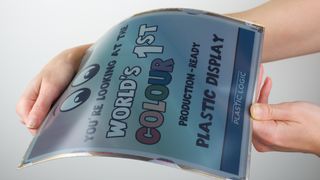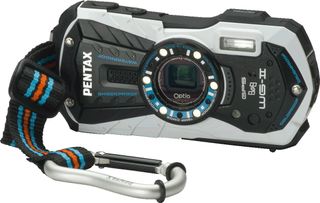How wireless charging will change our devices
Plus: can more efficient displays make a difference?
Meanwhile, Cambridge, UK-based 'organic electronics' components manufacturer Plastic Logic has come up with a way of printing – even spraying – electronics on flexible plastic sheets. Such electro-plastic displays (EPD) can show simple Flash-based video animations at 12 frames per second, and in full colour, but they're really intended to complement an LCD screen, not replace it. The paper-thin screen technology could soon find its way into both high-end and entry-level devices such as bendable phones and wraparound smart watches, or as an extra, though largely weightless, second screen on a smartphone like YotaPhone.
Industrial designers have clearly got a lot of work to do; the 'death of e-ink' predicted a few years ago was a false dusk indeed.

What about wireless charging?
"When they come to write the history of computing, 2013 will be the year that they select for the arrival of wireless power," says Curran, who expects to see wireless chargers outselling standard ones very quickly. Wireless charging is achieved through a process of electromagnetic induction whereby a current is sent from a coil in a charging pad to a coil embedded in a gadget placed a few centimeters away. As the device has to be either laid down on, or a very short distance (about four centimeters) from its charging pad, it's also not that easy to use a smartphone or tablet while it's charging. The designers clearly have some work to do for those who like to use their smartphone or tablet while it charges.
So far we've seen various devices under the umbrella of Duracell's Powermat, and Palm's magnetic Touchstone dock for its Palm Pre, which uses a proprietary wireless charging system, but more are coming. Many, many more.
Proprietary? That spells 'format war'!
Well spotted. Just like the Blu-ray Vs HD-DVD bore-fest, and lately the shenanigans between Panasonic's active shutter and LG's polarised systems that helped ruined the whole 3D TV idea, battery boffins at Duracell and Energizer have each come up with their own systems that they each believe is superior. Duracell's is based upon the Powermat idea it's been long developing, with supporters shielding behind the Power Matters Alliance (PMA). It's same the yearning for worldwide licensing royalties that causes every format war (isn't unrestricted capitalism awesome?).
On the other side of the fence is the Qi standard created by Energizer, which is supported by the Wireless Power Consortium (WPC).

There are others, including PowerByProxi, a technology that can charge several devices simultaneously on the same charging pad, unlike Qi or Powermat. It also uses a 'loose coupling' array to enable a device to receive an equal charge anywhere on a charging mat. "Many systems like Qi only report peak efficiency, which occurs at such precise alignment and positioning on the pad that most users will never experience it," a spokesperson told TechRadar.
Get daily insight, inspiration and deals in your inbox
Get the hottest deals available in your inbox plus news, reviews, opinion, analysis and more from the TechRadar team.
PowerByProxi's 'killer app' could be the freedom and ease of placement offered by its unique charging box idea. "Household devices can simply be put in the box when the batteries get low."

Who's in the PMA camp?
BlackBerry, LG, Google, NEC, Texas Instruments, AT&T, Starbucks, Otterbox, IDT, ZTE (the world's fourth-largest handset manufacturer) and wireless charging spot provider PowerKiss are on Duracell's side, among 57 members in total.
The latter joined the PMA in February 2013, stating that it would deploy wireless power in select McDonald's restaurants in Europe. It already operates conventional charging points train stations including in London Paddington and the Gare de Lyon in Paris, 16 European airports (including Belfast, Birmingham, Bristol, Liverpool, Manchester and Newcastle). Expect wireless upgrades soon. "Our decision to become a PMA member was based on several factors," said Maija Itkonen, CMO and Founder of PowerKiss.
"The PMA system has a unique layer of telco-grade intelligence that allows venues to monitor the health, usage and policies of all their charging spots. Secondly, we believe the PMA now enjoys the momentum and the necessary investment from major industry players to bring wireless power to life for consumers."
Jamie is a freelance tech, travel and space journalist based in the UK. He’s been writing regularly for Techradar since it was launched in 2008 and also writes regularly for Forbes, The Telegraph, the South China Morning Post, Sky & Telescope and the Sky At Night magazine as well as other Future titles T3, Digital Camera World, All About Space and Space.com. He also edits two of his own websites, TravGear.com and WhenIsTheNextEclipse.com that reflect his obsession with travel gear and solar eclipse travel. He is the author of A Stargazing Program For Beginners (Springer, 2015),

